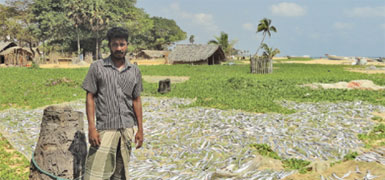Ex-Tigers turn successful entrepreneurs
By Gamini Warushamana
The Rehabilitation Authority (RA) has made successful entrepreneurs
out of around 11,500 ex-LTTE cadres supporting them in vocational
training and providing capital to start self-employment ventures.
 |
|
Santhirasegaram Sivaraja of Kallappadu
South, Mullaithivu, is a successful entrepreneur. He bought
a fishing boat and set up a dry fish production venture. |
“We have released over Rs. 255 million at 4 percent interest to over
1,500 rehabilitated ex-LTTE cadres to start livelihood ventures under
phase one of the livelihood support project,” said Chairman of the
Authority, E.A Samarasinghe. There were around 12,000 ex-LTTE cadres who
were either arrested or surrendered to the security forces during the
final phase of the war against terrorism.
They had undergone combat training and had been fighting for the LTTE
after they had joined the LTTE willingly or unwillingly. Most of them
did not have a proper education or any other skill to find a job or
start an economic activity after reintegration with society.
Considering the social and economic issues these youth had to face,
the office of the Commissioner General of Rehabilitation provided
vocational training for them during the rehabilitation period. After
rehabilitation, the RA had the responsibility of socially reintegrating
these youth.
Minister of Rehabilitation and Prison Reforms, Chandrasiri Gajadeera
proposed a soft loan scheme to provide initial capital. It financially
supports them to launch livelihood projects and there are a large number
of success stories under this scheme, Samarasinghe said.
RA has provided a maximum of Rs. 250,000 per person at 4 percent
interest with a 10-year repayment period and a maximum grace period of
one-year. The period depends on the nature of the project and if the
project can generate revenue immediately, there is no grace period.
There are several stakeholders in this project. The three state
banks, the Bank of Ceylon, People's Bank and the Sri Lanka Savings Bank
provide funds and the Treasury provides 8 percent interest subsidy to
the banks. Rs. 300 million has been allocated for phase one of the
project and by the end of February 1,549 beneficiaries had received the
loans.
Loan disbursement of phase one will be completed by the end of April
and 2,000 beneficiaries will receive loans.
A Cabinet paper has already been submitted for phase 2 of the project
and Rs. 550 million has been requested. RA hopes to support all
rehabilitated youth who need financial support.
They have commenced projects in agriculture, fisheries, domestic
industries and small businesses sectors. There are 262 beneficiaries in
Jaffna, 312 in Kilinochchi, 357 in Mullaitivu, 41 in Trincomalee, 267 in
Mannar, 294 in Vavunia, 10 in Batticaloa, 4 in Ampara.Deputy director of
RA, Ananda Wijepala said that most of the projects were successful. “The
RA provides enterprise development training programs for the
beneficiaries and we closely monitor the livelihood projects.
These rehabilitated people too want to restart their lives with
stable employment and integrate with society.” On the other hand there
is a demand for some products and service they supply from these
ventures in the domestic market.
For instance demand for masonry and carpentry work and services have
high demand.The agriculture sub projects are vulnerable to market
failures and we cannot meet these issues because these are small
projects that are scattered in a large geographical area. However, we
are attempting to form producer groups.RA successfully launched a
similar credit scheme for displaced families who were resettled in 2010
and its loan repayment rate was over 97%, which was the highest among
similar livelihood schemes, he said. |



